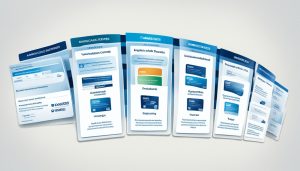Applying for a mortgage can feel overwhelming, but with USAA, the process is simplified. Whether you’re a first-time buyer or it’s been a while since your last home purchase, understanding the USAA mortgage loan application process is crucial. This article will guide you step-by-step, ensuring a smooth and successful application.
Key Takeaways:
- USAA provides a simplified mortgage loan application process.
- Whether you’re a first-time buyer or experienced, understanding the process is crucial.
- Follow our step-by-step guide for a smooth and successful application.
- Consult with USAA for personalized guidance and expert advice.
- Apply with confidence knowing you have a trusted partner in USAA.
Putting Yourself on a Budget
Before starting the mortgage application process, it’s important to put yourself on a budget. By managing your finances effectively, you can increase your chances of a successful mortgage loan application with USAA.
USAA recommends tracking your monthly spending and comparing it to your income. This allows you to assess whether you’re spending less than what you earn, and helps you prioritize your expenses accordingly. Creating a budget helps you allocate your funds wisely and ensures you have a clear understanding of your financial situation.
When creating a budget, consider categorizing your expenses into needs and wants. Focus on essential expenses like housing, utilities, groceries, and transportation first. Then, allocate funds for discretionary spending like entertainment and dining out.
Financial discipline is essential when applying for a mortgage with USAA. It demonstrates your ability to manage your finances responsibly and make timely mortgage payments.
Tracking Monthly Spending
To track your monthly spending effectively, consider using budgeting tools or apps that can automatically categorize your expenses. This allows you to easily see where your money is going and identify areas where you can make adjustments.
Tracking your spending and sticking to a budget not only helps with your mortgage application, but it also improves your overall financial well-being. It allows you to save for the future, pay off debts, and achieve your long-term financial goals.
Comparing Income and Expenses
When comparing your income to your expenses, it’s important to ensure that your income exceeds your expenses. This provides a buffer for unexpected costs and allows you to save for emergencies or future financial goals. If your expenses exceed your income, consider finding ways to reduce your spending or increase your income.
| Income | Expenses |
|---|---|
| Salary | Housing |
| Investment dividends | Utilities |
| Side hustle income | Groceries |
| Transportation | |
| Debt payments | |
| Discretionary spending |
Seeking Professional Advice
If you’re unsure how to create an effective budget or need assistance in managing your finances, consider seeking professional advice. Financial advisors or budgeting experts can provide personalized guidance, help you create a budget that aligns with your specific goals, and ensure you’re on the right track towards homeownership.
By putting yourself on a budget and demonstrating financial discipline, you’ll be better prepared to navigate the mortgage loan application process with USAA.
Considering Homeownership Costs
When applying for a mortgage with USAA, it’s crucial to consider all homeownership costs. Along with your mortgage payment, other expenses like property taxes, homeowners insurance, closing costs, private mortgage insurance (PMI), and ongoing maintenance should be taken into account.
These additional costs can significantly impact your monthly budget and overall affordability. Property taxes vary depending on the location and value of your home, while homeowners insurance protects your investment from potential damages. Closing costs encompass various fees associated with the purchase of a home, and private mortgage insurance may be required if your down payment is less than 20%.
To help potential homeowners understand these costs, USAA provides tools and resources to estimate and plan for these expenses. It’s essential to budget accordingly and be prepared for yearly increases in these costs, as property taxes and insurance premiums may fluctuate.
Sample Quote:
“Owning a home comes with a range of expenses beyond your monthly mortgage payment. Taking into account property taxes, homeowners insurance, closing costs, private mortgage insurance (PMI), and ongoing maintenance will ensure you have a realistic understanding of the costs associated with homeownership.”
– Emily Smith, Mortgage Expert at USAA

Planning Your Budget
To effectively manage these homeownership costs, USAA recommends creating a comprehensive budget that takes into consideration all of these expenses. Start by assessing your current financial situation and setting financial goals. This will help you determine how much you can comfortably afford to spend on housing expenses.
Use USAA’s budgeting tools and calculators to analyze your income, expenses, and debt-to-income ratio. It’s important to ensure that your mortgage payment, including taxes and insurance, fits within your budget without causing financial strain.
By understanding and factoring in these homeownership costs, you can make informed decisions during the USAA mortgage loan application process, ensuring a smooth and successful journey to owning your dream home.
| Homeownership Costs | Estimated Annual Cost |
|---|---|
| Property Taxes* | $4,000 |
| Homeowners Insurance | $1,200 |
| Closing Costs | $6,000 |
| Private Mortgage Insurance (PMI) | $1,800 |
| Ongoing Maintenance | $2,000 |
*Note: Property tax amounts are estimates and may vary depending on location and property value.
Planning for Changing Finances
Applying for a mortgage with USAA requires careful planning and consideration of your future financial circumstances. It’s important to account for potential changes in your income or career setbacks to ensure you make a well-informed decision.
USAA emphasizes that your purchase price and overall homeownership expenses should align with your financial situation, both currently and in the future. By carefully evaluating your long-term financial goals and potential challenges, you can make a more informed decision when applying for a mortgage with USAA.
Assessing Future Financial Stability
When considering a mortgage application with USAA, it’s crucial to assess your future financial stability. Some factors to keep in mind include:
- Career Growth: Take into account the potential for career advancements and salary increases, which can positively impact your ability to afford a mortgage.
- Possible Setbacks: Consider the likelihood of unexpected events such as job loss, medical emergencies, or other unforeseen circumstances that may impact your income.
- Household Changes: Evaluate potential changes in your household, such as starting a family, that may impact your financial situation and ability to afford a mortgage.
Setting Realistic Expectations
While it’s exciting to imagine your dream home, it’s important to set realistic expectations based on your current and anticipated financial circumstances. USAA recommends consulting with a mortgage specialist who can help you determine a comfortable budget and guide you towards properties within your means.
Remember, it’s better to have a mortgage that aligns with your long-term financial goals rather than stretching your budget to the limit. Being proactive and planning accordingly will help you avoid financial stress and ensure a smoother and more enjoyable homeownership journey.

| Factors to Consider: | Best Practices: |
|---|---|
| Future career growth and income potential | Evaluate your career trajectory and potential income increases over time. |
| Possible setbacks or income reductions | Plan for unexpected events that may decrease your income and factor them into your budget. |
| Anticipated changes in your household | Consider future changes in your household size and financial responsibilities. |
| Consulting with a mortgage expert | Work with a mortgage specialist to determine a realistic and affordable budget. |
By considering all these factors and planning for changing finances, you can ensure that your mortgage application with USAA is based on a solid financial foundation. Taking the time to evaluate your future financial circumstances will help you make a well-informed decision and secure a mortgage that aligns with your goals and aspirations.
Determining Affordability
When applying for a USAA mortgage loan, it’s essential to determine your affordability to ensure a successful application. Lenders take into account various factors such as your income, debt levels, and other requirements to determine your loan eligibility. However, it’s equally important to consider your own monthly budget and financial goals when deciding on your mortgage payment.
USAA recommends limiting your monthly mortgage payment to 28% of your gross monthly income. This guideline helps ensure that your mortgage payment remains manageable and doesn’t overly strain your finances. By selecting a payment within this range, you can maintain flexibility and meet other financial obligations comfortably.

It’s crucial to strike a balance between realizing your homeownership dreams and maintaining financial stability. USAA’s experienced team can provide personalized guidance to help you determine the mortgage amount that aligns with your budget and long-term financial objectives.
Paying Down Debts
Lowering your outstanding debts can play a significant role in strengthening your position when applying for a USAA mortgage loan. By reducing your debts, you not only improve your creditworthiness but also increase the amount you can borrow. Additionally, paying down your debts may potentially lower the cost and fees associated with your mortgage.
USAA recommends focusing on reducing your debts prior to submitting your mortgage application to improve your chances of loan approval. By taking proactive steps to eliminate or reduce high-interest debts, you can demonstrate financial responsibility and show lenders that you are capable of managing your debts effectively.
Here are a few strategies to help you pay down your debts:
- Create a budget: Start by assessing your monthly income and expenses. Identify areas where you can reduce spending and allocate more funds towards debt repayment.
- Pay more than the minimum: Whenever possible, strive to pay more than the minimum payment required on your debts. This will help you make progress towards paying off your debts faster and save money on interest charges.
- Focus on high-interest debts first: Prioritize paying off debts with the highest interest rates, such as credit card balances. By eliminating high-cost debts, you can save money in the long run.
- Consider debt consolidation: If managing multiple debts becomes overwhelming, explore the option of consolidating your debts into a single loan with a lower interest rate. This can simplify your repayment process and potentially save you money.
Taking steps to pay down your debts not only improves your financial health but also increases your chances of obtaining a favorable mortgage loan with USAA. By demonstrating responsible debt management, you present yourself as a reliable borrower and enhance your overall financial profile.

Understanding Mortgage Options with USAA
When applying for a mortgage with USAA, it’s important to have a clear understanding of the different mortgage options available to you. USAA offers two primary types of mortgages: fixed-rate mortgages and adjustable-rate mortgages (ARMs).
Fixed-Rate Mortgages
A fixed-rate mortgage is a popular choice for many homebuyers. With this type of mortgage, the interest rate remains the same for the entire term of the loan, ensuring consistent monthly payments throughout. This stability can provide peace of mind and make budgeting easier.
USAA’s fixed-rate mortgages are available in various terms, such as 15-year and 30-year. It’s important to consider your financial goals, repayment capabilities, and future plans when choosing the term of your fixed-rate mortgage.
Adjustable-Rate Mortgages (ARMs)
If you’re looking for flexibility and potentially lower initial interest rates, an adjustable-rate mortgage (ARM) may be worth considering. With an ARM, the interest rate is fixed for an initial term, typically 3, 5, 7, or 10 years, and then adjusts periodically based on market conditions.
Typically, ARMs have lower interest rates during the initial fixed-rate period, which can result in lower monthly payments. However, it’s important to be aware that the rate and monthly payment can fluctuate over time as market conditions change.
USAA provides detailed information on their website regarding the specific terms and options available for both fixed-rate and adjustable-rate mortgages, helping you make an informed decision based on your unique circumstances and financial goals.

Choosing the Right Mortgage Option
When deciding between a fixed-rate mortgage and an adjustable-rate mortgage, it’s important to consider several factors:
- Your current financial situation and long-term financial goals
- Your anticipated homeownership timeline
- Your comfort level with potential changes in monthly payments
With a fixed-rate mortgage, you have the security of a predictable monthly payment and can take advantage of historically low interest rates. On the other hand, an adjustable-rate mortgage offers lower initial rates and the potential for savings during the initial period.
Having a clear understanding of your financial goals and future plans will help you choose the mortgage option that aligns best with your needs and aspirations.
Regardless of the mortgage option you choose, USAA’s experienced team of mortgage professionals will guide you through the application process and ensure your questions are answered.
Conclusion
Navigating the USAA mortgage loan application process can feel overwhelming, but by following these steps, you can simplify the journey and increase your chances of a successful application. Start by putting yourself on a budget and ensuring your finances are in order. Consider all homeownership costs, including taxes, insurance, and maintenance, to avoid any surprises. Plan for potential changes in your finances, and choose a mortgage payment that aligns with your income and goals.
Paying down debts can improve your creditworthiness and strengthen your application. Take the time to understand the various mortgage options offered by USAA, such as fixed-rate and adjustable-rate mortgages, and choose the one that best suits your needs. Throughout the process, don’t hesitate to consult with USAA for personalized guidance and expert advice.
Remember, the key to a successful USAA home loan application is preparation and attention to detail. By taking these steps, you’ll be well on your way to achieving your dream of homeownership. Good luck!




No comments! Be the first commenter?